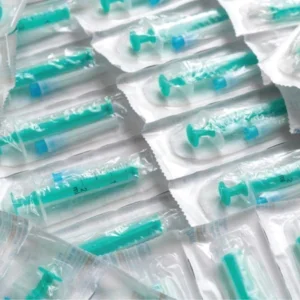
An increasing number of pharmaceuticals and biopharmaceuticals require shipping at precise temperatures. Cold-chain management is unique in that it guarantees the temperature regulation of such products along the entire supply chain to ensure that perishable products are distributed under refrigerated or frozen temperature conditions. The global pharmaceutical cold chain logistics industry is currently estimated to be worth $15.7 billion in 2019, an increase of 4.5% on 2018 figures. Many pharmaceuticals and biopharmaceuticals necessitate shipping between 2°C and 8°C, with the exact temperature dependant on the specific temperature tolerances of the product being shipped.
There are several steps to the cold-chain logistics process. The first of these is supply, where drugs are manufactured and packaged at a plant. The second is transportation, where products are often moved in refrigerated or insulated trucks, which undergo routine inspections to ensure they are capable of maintaining the correct temperature. The next stage is storage, where drugs might go into cold storage before they are distributed; this refrigerated warehouse serves as a middle ground before pharma products reach their final destination. The last step in the process is delivery to the final destination, where the drug is administered.
$15.7 billion
The global pharmaceutical cold-chain logistics industry’s projected worth in 2019.
Pharmaceutical Commerce
From the factory to the point of delivery, a pharmaceutical’s integrity and quality must be maintained: temperature-sensitive products must remain within their defined temperature limits to avoid any impact on their quality or stability, which may subsequently affect their efficacy for patients. The pharmaceutical industry works under tight regulations – and so does the shipping industry.
“The labelled storage conditions should be maintained during transportation in accordance with regulatory guidance,” says Eva-Lotta Persson, clinical supply chain lead at AstraZeneca. “The EU guidance on good distribution practice [GDP] of medicinal products for human use states that for temperature-sensitive products, qualified equipment – for example, thermal packaging, temperature-controlled containers or temperature-controlled vehicles – should be used to ensure correct transportation conditions are maintained between the manufacturer, wholesale distributor and customer.”
Due to advancements in science, there has been a shift towards more sensitive products entering clinical testing, explains Persson. Biopharmaceutics is a rapidly growing sector in the pharmaceutical industry, and they often require very careful handling. Biologic drugs – which are derived from living organisms or contain components of living organisms – also tend to fall within the same bracket.
“It is key to understand the sensitivity of the product and ship it accordingly,” Persson states. “For earlyphase studies there might be limited amounts of stability data available, and thus a requirement for shipping materials in a controlled environment.”
Route causes
Transporting temperature-sensitive products has become more than merely moving them from one place to another; it is a moveable method of storage. Special consideration is needed when analysing the routes for a product shipment to ensure that it gets from A to B safely, and remains within its defined temperature range to avoid wastage. Firstly, the distance may pose a problem; even within a single country, the journey can be extremely long and require different modes of transportation – for example, truck, train or air. It also often involves transfers between different modes of transport, and materials could be left sitting on a dock or on tarmac for a period of time, says Persson.
When it comes to distributing pharmaceuticals, time is of the essence. If the material is to be imported across borders, there is the potential for it to be held up in customs, waiting for clearance; this time delay could affect the product’s efficacy.
“It is key to have all the paperwork ready to achieve the most efficient clearance process,” states Persson. “For markets with many sites, or lengthy and complex importation procedures, it can often be beneficial to set up a local depot in a country and ship larger quantities of material in better-controlled shippers, rather than having lots of smaller shipments needing to cross the border for individual site shipments.”
The surrounding environment can also play a part. Clinical supply chains often cover a global range of countries and, as such, the surrounding temperature will have an impact, explains Persson. There are different climates in different regions, but also seasonal changes, differences in day and night temperatures and weather extremes that occur.
“Given all of these different factors, there is often not one solution that can be applied to all shipments,” says Persson. “A risk-assessment exercise could prove valuable, especially when shipping high-value goods or goods that are difficult to replace. It is then key to understand how the products are shipped, where transfers will occur and what modes of transportation will be used.”
Counting the cost of waste
Product wastage can occur at several stages in the cold chain, but is most likely to happen with site shipments, states Persson. “Site shipments are by far the most likely to have temperature excursions, as these are smaller shipments in high numbers,” she says.
Pharmaceuticals are delicate but can also be expensive, and there is the potential for wastage to occur at several stages in the cold chain. There are different types of waste associated with site shipments, and it is important to find the correct balance between these.
Firstly, there is waste of the product, says Persson. “If there are not enough controls in the shipping procedures and correct use of thermal insulation, there is a risk of the products being subjected to excursions, making them not fit for use. This risk carries supply issues if the product is difficult to replace, but also a cost aspect for replacing the product and the need for making a new shipment.”
So, cost is also a factor. Aside from the expense of needing to supply replacement materials, the cost of cold-chain shipments is more expensive than shipping material in ambient conditions.
“There are several shippers available, all associated with different costs, and the best type of shipper needs to be selected based on the product sensitivity, distance and route for the shipment, including an evaluation of the environment that the shipment will encounter,” states Persson. “There are also different couriers that can provide tailored services at different costs.”
There is also a cost associated with environmental footprint. “Cold-chain shippers require a lot more packaging material, and add extra weight and volume during shipping compared with ambient shippers, and as such they will have a larger impact on carbon footprint,” explains Persson. “Disposal of shippers can also be a real issue for the clinical sites.”
Persson suggests a review of the materials used and trying to find a balanced option – including the environmental footprint – should be included when determining how to ship investigational medicinal products. One option could be to look at reusable shippers, she believes.
Delivery failure and product characteristics
There is also the out-of-drug (OOD) perspective to consider. Most supply chains are built on a pull system wherein the IxRS-system (interactive voice/interactive web response system) will produce orders based on planned ongoing supplies to enrolled patients and an estimated rate of new patients being enrolled.
“Should a shipment fail, there is a clear risk that the supply will not make it to the site on time and either prevent new patients from being enrolled, or risk that the already-enrolled patients cannot receive study medication – potentially compromising both patient health and clinical-study quality,” explains Persson. “As such, this is often seen as the worst type of waste and an indicator to monitor closely.”
Key to avoiding wastage in the cold chain is to understand the characteristics of the products. Persson suggests keeping in mind three key questions: how sensitive is it to changes in temperature? How many cycles of temperature changes can occur without changes to product quality? Is it okay after being frozen or thawed? The freezing of water can have large and unexpected effects on chemical stability as well as physical stability, and might be worth paying extra attention to if a device is supplied with the pharmaceutical product.
“In the end, it is our job to ensure products reach patients in a timely way and to the right quality, to make sure patient safety is maintained, and at the same time being confident that the quality of the results from clinical studies is safeguarded,” says Persson.
Shipping temperature-sensitive pharmaceuticals and biopharmaceuticals is big business. It is a challenging task to ensure products are moved from A to B without straying from their defined temperature limits, but the cold chain is designed to guarantee the temperature regulation of such drugs. There is much to consider; a risk assessment would help pinpoint places where temperature excursions might occur and how to avoid them. This will ensure wastage is minimised, and the pharmaceutical reaches its intended recipients safely and in a timely manner.
The growth of cold chain
The pharma industry stands at a defining moment. According to the ninth edition of Pharmaceutical Commerce’s Biopharma Cold Chain Sourcebook, the sales of global cold chain and biopharma drugs are set to grow by 31% (from $318 billion to $416 billion) in 2018–22, outpacing the non-cold-chain growth at 17% ($870 billion to $1.014 trillion), and the overall volume of temperature-controlled pharma products is growing at twice the rate of the pharma industry as a whole. This reflects an overall growth trend of 53% since 2016. Likewise, logistics spending in the cold-chain space is expected to grow from $15 billion ($10.6 in transportation and $4.4 in tertiary packaging and instrumentation) in 2018 to over $18.6 billion in 2022.
However, evolving patient-centric delivery models, expanding temperature-sensitive portfolios through an influx of new product developments, varying operating practices to fulfil regulatory guidelines, and increasing physical and cyber threats mean that crucial supply chain stability is now under severe threat. Furthermore, regulations are expanding beyond drug transportation to ingredients transportation and safety. The move towards biologic-based therapies also means that the importance and scrutiny on cold chain will only intensify over the next decade.
To stay ahead of the curve and achieve GDP, life-sciences manufacturers need to:
- achieve the optimal equilibrium between patient centricity, operational and cost-efficiency
- adopt innovative, cost-effective and sustainable solutions and technology quickly
- establish end-to-end supply chain collaboration and standardisation.
Source: Pharma Logistics IQ





